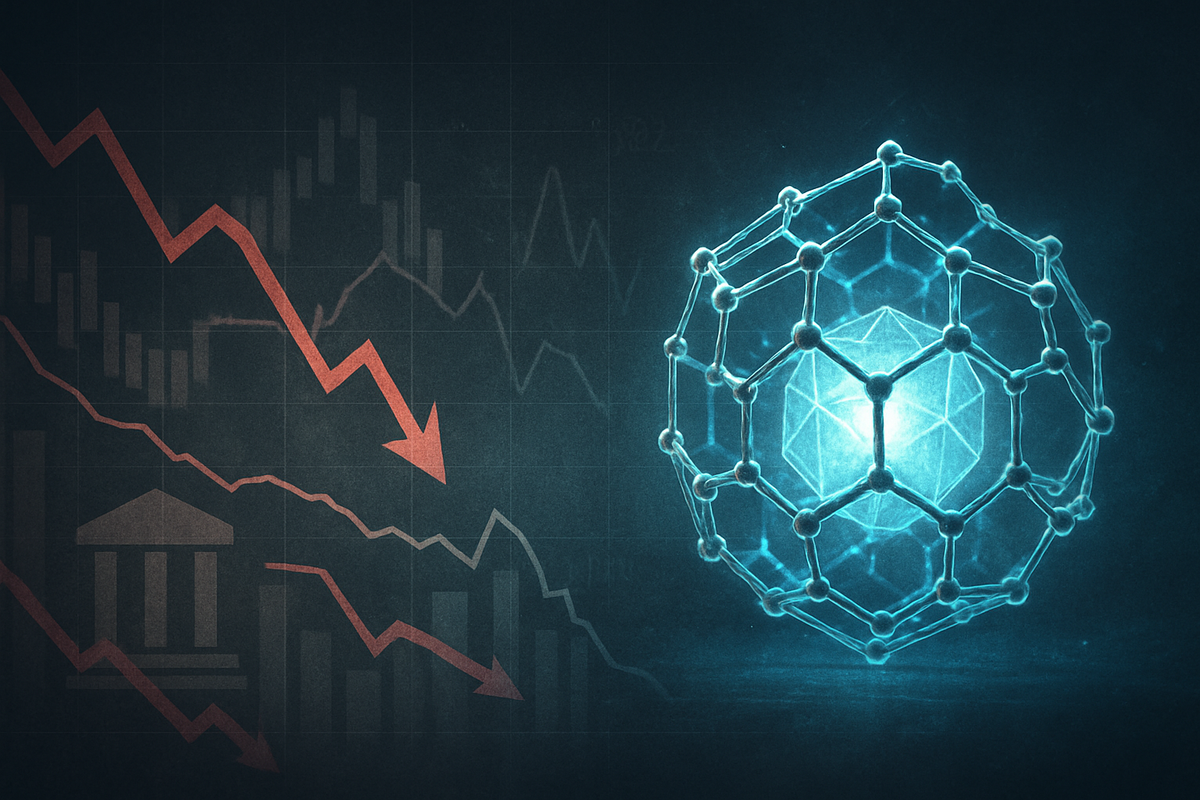
Graphene Manufacturing Group (GMG) (TSXV: GMG) finds itself at a pivotal juncture, grappling with persistent financial hurdles that cast a shadow over its ambitious endeavors to commercialize graphene-enhanced products. As of October 6, 2025, the company continues to report significant losses and negative cash flow, a common but challenging phase for innovative technology firms in their development cycles. This financial strain highlights the substantial capital investment required to transition groundbreaking graphene research into viable market solutions, raising questions about the pace and viability of widespread graphene adoption as a commodity.
The immediate implications for GMG are clear: a sustained reliance on external financing to fuel its operations and growth initiatives. For the broader graphene market, GMG's situation serves as a stark reminder of the long and arduous path from scientific discovery to commercial profitability, underscoring the capital-intensive nature of bringing advanced materials to market and the extended timelines necessary to achieve commercial success and economies of scale.
Detailed Coverage: A Closer Look at GMG's Financial Landscape
Graphene Manufacturing Group's financial reports paint a picture of a company in an aggressive development phase, characterized by high expenditure and nascent revenue streams. For the fiscal year ended June 30, 2024, GMG reported a loss of AUD 7,400,878, following a loss of AUD 9,323,665 in the previous year. The unaudited condensed interim financial statements for the three months ended March 31, 2025, further revealed a net loss of AUD 1.76 million, accumulating to a net loss of AUD 5.31 million for the nine months ended March 31, 2025. Revenue figures remain modest, with AUD 0.049549 million for the three months ended March 31, 2025, a slight decrease from the prior year.
Key expenditures driving these losses include substantial employee benefit expenses (AUD 6,063,086 in FY2024), professional and consulting fees (AUD 3,227,741 in FY2024), and depreciation and amortization expenses (AUD 1,977,430 in FY2024). These figures underscore the significant investment in human capital, expertise, and infrastructure necessary to develop and scale graphene technologies. The company's cash flow statements consistently show a negative operating cash flow, with AU$-1.88 million for FY2024 and AUD (1,076,089) for the three months ended September 30, 2024.
To counteract these cash outflows, GMG has actively engaged in financing activities. This includes proceeds from share issues and the exercise of share warrants, such as the AUD 893,182 recorded in net cash from financing activities for the three months ended September 30, 2024. A past public offering also secured C$6.9 million (approximately AUD 7.6 million). CEO Craig Nicol has consistently emphasized the company's progress in product development, particularly with G®Lubricant and graphene aluminum-ion batteries, highlighting their high-value proposition and potential for significant margins. Updates in March and July 2025 have focused on commercial deals, regulatory approvals, and distribution partnerships, indicating a strategic push towards revenue generation as the primary path to sustainable financial health. Initial market reactions, while acknowledging the potential of GMG's innovations, remain cautious, reflecting the broader investment community's wait-and-see approach to early-stage advanced materials companies.
Company Impact: Winners and Losers in the Graphene Race
The financial performance of Graphene Manufacturing Group (GMG) (TSXV: GMG) has ripple effects across the nascent graphene industry, potentially shaping the fortunes of various players. While GMG's struggles might seem like a negative signal, they also illuminate the intense competition and the high bar for commercial success in this sector.
Companies that could "win" from GMG's challenges, or at least gain relative advantage, are those with stronger financial backing, more diversified product portfolios, or more established revenue streams in specific graphene applications. For instance, larger chemical companies or materials science giants that have invested in graphene research, such as BASF (ETR: BAS) or Saint-Gobain (EPA: SGO), might find it easier to absorb the high R&D costs and longer commercialization timelines. Their existing market channels and robust balance sheets provide a buffer against the financial volatility seen in pure-play graphene startups. Furthermore, companies focusing on niche, high-value applications of graphene that require less capital-intensive scaling, or those with proprietary manufacturing processes that significantly reduce production costs, could also emerge as stronger contenders. For example, companies developing graphene-enhanced sensors or specialized coatings may have a more direct path to profitability.
Conversely, GMG itself, and other smaller, pure-play graphene developers, face significant "losing" propositions if they cannot secure consistent funding or accelerate their path to profitability. The ongoing need for capital injections dilutes existing shareholder value and can make it challenging to attract new investors. Companies heavily reliant on a single or limited range of graphene applications, without a robust pipeline of diverse products, are particularly vulnerable. The market's perception of graphene as a viable, scalable commodity is also at stake; if a prominent player like GMG struggles to convert innovation into revenue, it could dampen overall investor enthusiasm for the sector, making it harder for all graphene-focused companies to raise capital. Competitors offering alternative advanced materials, or even traditional materials that graphene aims to replace, might also see a temporary reprieve or extended market dominance if graphene's commercialization is delayed by financial hurdles faced by its pioneers.
Wider Significance: Graphene's Maturation and Market Dynamics
GMG's financial journey is not an isolated incident but rather a microcosm of the broader challenges facing the advanced materials industry, particularly for groundbreaking technologies like graphene. This event fits into a wider trend where novel materials, despite their transformative potential, encounter significant hurdles in scaling from laboratory to industrial production and achieving widespread commercial adoption. The capital intensity, the need for stringent quality control, and the often-protracted regulatory approval processes are systemic issues that many graphene companies, not just GMG, must navigate.
The potential ripple effects on competitors and partners are considerable. For competitors, GMG's struggles could serve as a cautionary tale, prompting a re-evaluation of their own financial strategies and commercialization timelines. It might also intensify the race to secure intellectual property and strategic partnerships, as companies seek to de-risk their investments. Partners, especially those collaborating with GMG on product development or distribution, might experience delays or reconsider their commitments if GMG's financial stability remains a concern. Conversely, if GMG successfully navigates these challenges and brings its products to market, it would validate the commercial viability of graphene applications, potentially unlocking further investment and accelerating the entire industry.
From a regulatory or policy perspective, the financial hurdles faced by companies like GMG highlight the need for supportive frameworks that can foster the growth of emerging technologies. This could include government grants, tax incentives for R&D, or streamlined regulatory pathways for novel materials. Historically, similar patterns have been observed in other groundbreaking technologies, such as early semiconductor development or the initial phases of biotechnology. Companies in these sectors often faced extended periods of losses and heavy R&D investment before achieving profitability. The key differentiator for success often lay in securing sufficient long-term funding, demonstrating clear value propositions, and effectively scaling production. The global graphene market, though still in its infancy, is driven by expanding applications in electronics, energy storage, and composites, with a strong emphasis on consistent quality and cost reduction. GMG's ability to overcome its current financial challenges will undoubtedly influence its competitive standing in this rapidly evolving landscape.
What Comes Next: Navigating the Path to Profitability
The immediate future for Graphene Manufacturing Group (GMG) (TSXV: GMG) will be defined by its ability to translate its technological advancements into tangible revenue streams. In the short term, GMG will likely intensify its focus on securing commercial contracts and expanding distribution channels for its flagship products, particularly G®Lubricant and THERMAL-XR®. The success of these initiatives will be crucial in demonstrating a viable path to profitability and reducing reliance on external financing. Continued progress in obtaining regulatory approvals for its graphene aluminum-ion batteries will also be a key indicator of future growth potential.
In the long term, GMG's trajectory will hinge on its ability to scale production efficiently and cost-effectively, maintaining quality consistency while driving down manufacturing costs. This will involve optimizing its proprietary graphene production process and potentially exploring strategic partnerships or joint ventures to expand its manufacturing footprint. Potential strategic pivots could include prioritizing certain high-margin applications over others, or even licensing its technology to larger players to accelerate market penetration and generate royalty income. The market opportunities that may emerge include a growing demand for sustainable and high-performance materials across various industries, from automotive to consumer electronics, where graphene's unique properties offer significant advantages.
Potential scenarios range from a successful commercialization leading to sustained profitability and market leadership in specific graphene applications, to a continued struggle for funding that could necessitate significant restructuring or even acquisition by a larger entity. A successful outcome would likely see GMG's stock price rebound as investor confidence grows, while a less favorable scenario could lead to further dilution or a decline in valuation. What comes next will be a testament to GMG's execution capabilities and the broader market's readiness to embrace graphene as a mainstream material.
Wrap-up: A Critical Juncture for Graphene's Future
Graphene Manufacturing Group's (GMG) (TSXV: GMG) current financial hurdles represent a critical, albeit not uncommon, phase for an innovative company aiming to revolutionize an industry. The key takeaways from this event are multi-faceted: the immense capital requirements for commercializing advanced materials, the extended timelines for achieving profitability, and the inherent pressures to convert groundbreaking research into scalable, revenue-generating products. As of October 6, 2025, GMG's ongoing losses and reliance on financing underscore the challenges, yet its continued progress in product development offers a glimmer of the potential that lies ahead.
Moving forward, the market will be closely watching GMG's ability to accelerate its commercialization efforts and demonstrate a clear path to positive cash flow. The company's success or struggles will undoubtedly influence the overall investment sentiment towards the graphene sector, potentially either validating its commercial promise or highlighting the significant barriers to entry and scalability. The lasting impact of this period for GMG could define its role as a pioneer in the graphene industry, or it could serve as a case study in the difficulties of bringing a truly disruptive technology to market.
Investors should closely monitor GMG's quarterly financial reports, focusing on revenue growth, gross margins, and operating cash flow. Key indicators will include the number and size of commercial contracts secured for G®Lubricant and THERMAL-XR®, as well as any significant advancements in the commercial deployment of its graphene aluminum-ion batteries. Furthermore, observing the broader graphene market for signs of increased adoption, technological breakthroughs by competitors, and evolving regulatory landscapes will provide crucial context for assessing GMG's long-term prospects. The journey of graphene from a scientific marvel to an everyday commodity is still unfolding, and GMG's performance will be a significant chapter in that narrative.
This content is intended for informational purposes only and is not financial advice.





